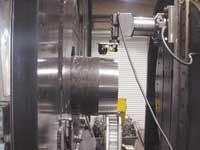Part I: Integral connections on large-bore pipe
By Rich DeLange, Jim Light Marvin Odum, Curtis Parker,Grant Prideco
Integral thread connections on large outside diameter (OD) casing may spur on dep-ressed shallow-water drilling programs by cutting costs. Despite strong deepwater activity, high natural gas drove shallow water drilling activity in the Gulf of Mexico to drop off sharply last fall. It is not yet showing any sign of recovery. US natural gas inventories stood at record high levels by the end of 2001, placing additional pressure on natural gas prices already depressed by the combined effects of economic recession in the US and an exceptionally warm November/December 2001. Nonetheless, large operators with significant deepwater holdings are continuing their deepwater drilling programs and are searching for cost-effective technologies to improve offshore E&P efficiency without compro- mising safety or the environment.
Large diameter casing strings
Conductor casing and the associated large OD pipe strings are costly and critical components of offshore wells. The installation processes of either jetting in or running and then cementing large OD casing also are expensive. The total installed cost of conductor and large diameter casing strings with conventional weld-on, quarter-turn connections can range from $1.5 million beyond $5 million per well, depending on the number of strings installed and the daily rig rate. In contrast, integral connections represent potential savings of hundreds of thousands of dollars per well versus conventional alternatives.
Recently selected by major operators for use in three of the largest deepwater projects ever undertaken in the Gulf of Mexico, Grant Prideco's XL Systems™ large OD integral thread connections have been the choice of many cost- and safety-conscious operators since their introduction in 1987. Cut directly into the pipe wall of large diameter (20-in. to 72-in. OD) marine conductors, conductor casing, and caissons, the proprietary integral connections provide flush annular clearances between strings, giving well designers significant flexibility to utilize combinations of casing and drilled hole sizes that would not otherwise be possible. The proprietary connections also enhance project safety and environmental risk management by mitigating the risks of thread jumpout and connection backoff that can result in dropped strings.
Large OD integral thread design
The integral thread design actually locks the pin and box connections together both longitudinally and radially. This locking action virtually eliminates the risk of jumpout failure, a major weakness of the other types of connections used on large OD pipe with pipe diameter/wall thickness ( D/t) ratios that often exceed 40. The security of the proprietary connection is attributable to the clamping action of the double hooked (dovetail) thread form design. The design configuration facilitates a secure connection without pushing the pin and box apart, thereby eliminating risk of creating another condition that can cause jumpout failure in alternative large OD thread designs.
The design also features a thread width that changes along the helix of the thread. The thread teeth on the pin and box are narrow near the end faces and wider near the back shoulders. Machining the thread teeth creates thread grooves (or gaps between the teeth) that are just the opposite: wide grooves near the end faces and narrow grooves near the back shoulders. When fully made-up, the thread tooth becomes a long helical wedge driven into a matching wedge-shaped groove. The inclined surfaces of the wedge are the load flank and stab flank of the thread.
The thread form also provides gaps at the thread flanks that gradually close as the connection is made-up (as the wedge is driven into the wedge-shaped groove). These gaps allow the connection to make-up freely, with low torque, until the thread flanks begin to engage. When the flanks engage, or touch, contact occurs along the entire thread length. After flank contact, only a small amount of additional rotation is required to reach the full make-up torque.
Resist unintentional anti-rotation
The additional rotation from initial flank contact to full make-up torque stores energy in the threads as frictional resistance along the entire thread helix. Friction over this large thread surface area is sufficient to resist unintentional anti-rotation, or backoff, of the connection. In fact, this simple system is so reliable that no mechanical anti-rotation tabs or pins or other devices are required. Not having to install anti-rotation devices during pipe running is a time- and labor-saving advantage of the XL thread connections over conventional quarter-turn connections. The conventional connections require mechanical anti-rotation devices to be activated or installed during pipe running. If an integral thread connection must be tripped for some reason, connection breakout is achieved simply by applying anti-rotation torque sufficient to overcome the frictional resistance that was "stored" in the connection during make-up.
Large OD integral thread developed
The XL division has been using its proprietary integral thread connection technology for 20-in. diameter and larger marine conductors since 1987. Prior to that time, large OD strings had been screwed together after thick, threaded forgings were welded to the ends of the large diameter pipe. Eliminating the costs for large diameter, heavy wall forgings and costs for welding these forgings to the pipe body gives integral connections an economic advantage over conventional weld-on connectors.
The first of the large OD integral threads developed was the XLF™ connection, which includes a flush OD/flush ID design, machined directly into/onto the wall of 20-in. to 48-in. OD pipe. This thread form uses a radial metal seal for internal pressure integrity and is appropriate for most marine applications involving relatively short strings, which require lower tensile strength in the connection than in the pipe body itself. This particular connection is best suited for use in run strings for which internal pressure is a primary design consideration. While the sealing mechanism in most weld-on large diameter connector designs is provided by elastomeric O-rings, this connection provides a radial-interference metal seal near the end of the pin that is effective for internal pressure control.
XLCS connector design
Soon after the introduction of this connection, an enhanced version of the original design was developed. The XLCS™ connector design includes enlarged root radii, which improve the connection's fatigue resistance and contributes to a stress concentration factor (SCF) adequate for long life under cyclic load conditions. The thread form was subjected to extensive engineering analysis to assess fatigue resistance and was thoroughly tested for fatigue life on a custom-built cyclic bending frame at the University of Oklahoma. This testing evolved into a fatigue life prediction model that has been verified by physical testing of full-scale specimens, a foolproof but expensive method of predicting fatigue resistance.
The design includes a seawater-excluding, radial-interference seal at the outside end of the connection that prevents corrosion and eliminates the risk of corrosion-induced premature fatigue failure. Unlike seawater seals with torque shoulders that are normal to the pipe body axis and sensitive to tension and bending loads, the radial metal seal functions regardless of applied mechanical loads.
(Right)The first of the large OD integral thread developed was the XLF connection, which includes a flush OD/flush ID design, machined directly into/onto the wall of 20-in. to 48-in. OD pipe.
Higher performance connections
As offshore drilling activity increased around the world during the 1990s, harsher environments required higher performance connections. The XLW™, XLF-RB™, and XLCS-RB™ connection designs enhanced the two original integral connection designs, giving operators integral thread connection options appropriate to even the most highly stressed sections or strings of large OD pipe within deepwater or ultra-deepwater wells.
The XLW connection is based on the XLF thread and seal design and adds a box that is machined onto a forging with an outside diameter larger than that of the pipe body. The pin thread is machined directly into the pipe wall, eliminating one forging and one welding operation on every joint compared to conventional weld-on designs. The geometry and performance features of the design are ideal for applications requiring a connection ID that is flush with the pipe body ID and that will be exposed to internal pressure.
(Left) The XLCS connector design includes enlarged root radii, which improves the connection's fatigue resistance and contributes to a stress concentration factor adequate for long life under cyclic load conditions.
The XLF-RB and XLCS-RB connections are standard XLF and XLCS thread forms that are machined onto short pipe sections whose wall thicknesses exceed those of the full-length pipe joints to which they are welded. These "reduced bore" connections are particularly well suited to highly stressed string sections, e.g., large OD strings run in deviated holes, that require a flush OD profile with connection strength greater than the string's pipe body strength. The raw materials used for the RB connection pins and boxes are standard pipe stock, an economic advantage over weld-on connections requiring special, high-strength forgings for their pin and box raw materials.
Threading integral connections
Threading integral connections directly into the wall thickness of large diameter pipe requires a unique manufacturing arrangement. Highly specialized computerized numerically controlled (CNC) machines control the speed, width, and depth of the cutting surface along the pipe wall as threads are cut into thick-walled, 20-in. to 72-in., diameter steel casing, conductors, and caissons. A computerized inspection system provides accurate dimensional control and ensures that every pin precisely fits every box so that no rig time will be wasted when the casing is installed at the offshore site.
A unique stabbing tool enables a two-man installation crew to run the threaded, large OD pipe quickly and easily.
The crew places the hydraulically powered stabbing device, which bears the weight of the pipe as connection make-up is initiated, into the rig elevator and slowly lowers each joint into place. The combination of the proprietary thread design guided into position by the weight-bearing stabbing tool eliminates any risk of cross-threading or stabbing damage.
Benefits
The integral connections provide a number of advantages compared to welded-on, quarter-turn alternatives. Their ideal flush OD and/or flush ID geometry improves annular clearances between strings, allowing well designers to use new, more economical hole and pipe size combinations as well as closer stacking of large OD strings. As a result, savings can be achieved in many combinations:
• Reduce volume of material drilled out of the hole
• Eliminate or minimize underreaming
• Allow use of optimally sized conductor casing at the surface
• Mitigate the piston effect and the associated risk of hydraulic fracture often encountered when running casing with small annular gaps
• Lower the risk of a connection shoulder catching or hanging up downhole
• Minimize expensive rig time
• Optimize casing costs
• Reduce cement and mud volumes
• Minimize cement pumping/mud circulation costs
• Eliminate the need for costly expandable liners in order to optimize hole size at TD
• Enlarge hole size at greater depths, enhancing risk management by giving the well planner the option of including contingency strings that might not otherwise fit.
Conclusion
The integral connections for large OD conductor, casing, and caisson installations are technologically and economically attractive solutions for improving the efficiency and reducing the total costs of conductor, casing, and caisson installations and their attendant safety and environmental risks in deepwater and shelf applications.
Part II of this article, in a future issue, will include examples of the actual savings realized through the improved annular clearances associated with use of the integral connections, which:
• Streamline the number and size of casing strings required
• Enhance mechanical and fatigue loads on the conductor and other large bore strings
• Allow total depth to be reached with optimal hole size and without the use of expensive expandable liners or tubulars
• Reduce total rig time compared to conventional connections.




